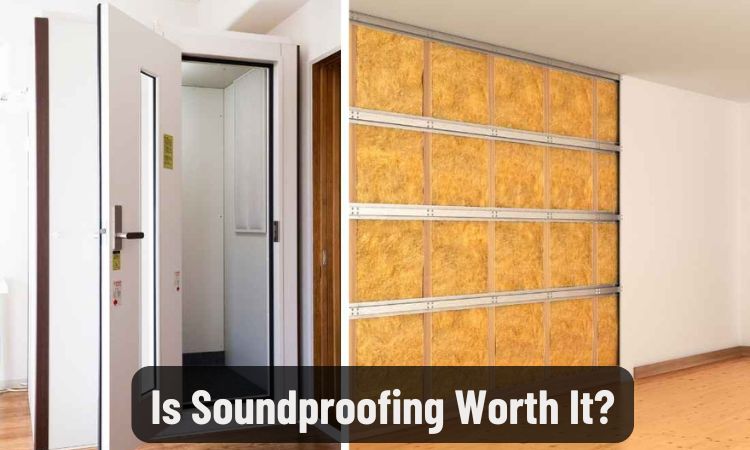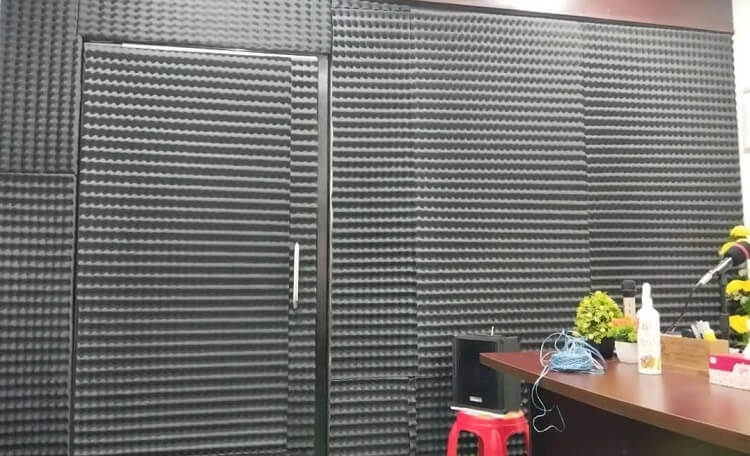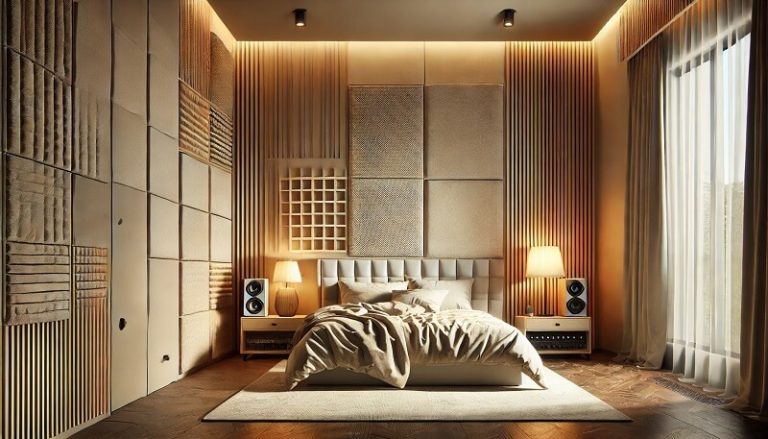
Noisy neighbors keeping you up at night? Struggling to focus or relax because of constant noise intrusion? If you’re asking yourself, “How can I soundproof a room for noisy neighbors?”, this guide offers practical solutions to reclaim your peace and quiet.
We’ll cover effective techniques and materials for reducing noise, from simple DIY fixes to professional-grade installations.
Assessing the Noise Problem
Before diving into solutions, it’s crucial to understand the nature of the noise you’re dealing with and pinpoint its entry points. This assessment helps tailor your soundproofing strategy for maximum effectiveness.
Identifying Noise Types
Different types of noise require different approaches:
- Airborne Noise: This includes voices, music, television sounds, and traffic noise that travel through the air. These sounds often pass through walls, windows, and doors.
- Impact Noise: This refers to vibrations caused by footsteps, dropped objects, slamming doors, or moving furniture.
These vibrations travel through floors, ceilings, and walls.
Pinpointing Weak Areas
Identify the areas in your room where noise enters most prominently:
- Walls: Thin walls, especially those made of lightweight materials, easily transmit both airborne and impact noise.
- Windows: Gaps around window frames and single-pane glass are major culprits for noise intrusion. Thin glass vibrates easily, amplifying external sounds.
- Doors: Hollow-core doors offer minimal sound insulation. Gaps beneath and around the frame further contribute to noise leakage.
- Floors and Ceilings: These are primary pathways for impact noise.
Inadequate insulation between floors can make upstairs neighbors’ footsteps sound like thunder.
Measuring Noise Levels
Using a decibel meter app on your smartphone can help quantify the noise levels and identify peak noise times. This data can be helpful in assessing the severity of the problem and tracking the effectiveness of your soundproofing efforts.
Best Materials for Soundproofing a Room
Selecting the right materials is crucial for effective soundproofing. Here’s a breakdown of commonly used options:
Mass Loaded Vinyl (MLV)
- Description: A dense, flexible material made of vinyl and other additives, weighing around one pound per square foot.
This high density effectively blocks sound transmission.
- Applications: Walls, floors, ceilings, and doors. Can be applied directly to surfaces or used as a layer within a wall assembly.
- Benefits: High STC (Sound Transmission Class) rating, relatively easy to install, versatile for various applications.
Acoustic Foam Panels
- Description: Lightweight, porous panels designed to absorb sound waves, reducing echo and reverberation within a room.
- Applications: Walls and ceilings in home theaters, studios, or any room where sound clarity and reduced echo are desired.
- Benefits: Improves room acoustics, minimizes internal noise reflections, relatively inexpensive.
Fiberglass Insulation
- Description: Thick, fibrous material that absorbs sound waves within wall cavities and ceilings.
- Applications: Filling wall cavities and attic spaces to dampen noise transmission.
- Benefits: Cost-effective, provides thermal insulation in addition to sound absorption.
Soundproof Curtains and Blankets
- Description: Heavy, dense fabrics designed to block and absorb some sound. These are typically made from materials like velvet, suede, or multiple layers of fabric.
- Applications: Windows and doors.
Can be used as a standalone solution for minor noise reduction or in conjunction with other methods.
- Benefits: Relatively inexpensive, easy to install, adds aesthetic appeal.
Green Glue
- Description: A viscoelastic damping compound applied between layers of drywall to dampen vibrations and reduce sound transmission.
- Applications: Walls and ceilings.
- Benefits: Significantly increases the STC rating of a wall assembly, relatively easy to apply.
Resilient Channels
- Description: Metal channels installed on walls and ceilings to decouple drywall from the framing, reducing vibration transfer.
- Applications: Walls and ceilings.
- Benefits: Effective in reducing impact noise transmission.
Step-by-Step Guide to Soundproof a Room
Here’s a practical guide to implement soundproofing measures:
Walls
- Add Mass: Install a layer of MLV directly to the existing wall, followed by a new layer of drywall. Use Green Glue between the MLV and drywall for optimal sound damping.
- Seal Gaps: Use acoustic caulk to seal any gaps around electrical outlets, pipes, vents, and cracks. This prevents noise from leaking through small openings.
- Install Acoustic Panels: Place strategically on walls to absorb sound reflections within the room, particularly effective for reducing echo and reverberation.
Windows
- Upgrade to Double Glazing: Replace single-pane windows with double or triple-glazed windows, which offer significantly better sound insulation.
- Apply Window Inserts: Acrylic or glass inserts create an additional air gap, further reducing noise transmission.
These fit within the existing window frame.
- Hang Soundproof Curtains: Use heavy, dense curtains to add an extra layer of sound absorption and blockage. Combine with other window treatments for maximum effectiveness.
Doors
- Replace Hollow-Core Doors: Install a solid-core door made of solid wood or a composite material for better sound resistance.
- Seal Edges: Apply weatherstripping around the door frame and a door sweep at the bottom to block gaps. This prevents air and sound leakage.
- Add Mass: Apply MLV to the door surface, covered by a decorative panel or fabric.
Floors and Ceilings
- Use Rugs or Carpets: Thick rugs or carpets absorb impact noise and reduce sound transmission.
- Install Underlayment: Use specialized soundproofing underlayment beneath flooring materials to dampen vibrations.
Choose a high-density underlayment for maximum impact noise reduction.
- Enhance Ceilings: Install acoustic ceiling tiles or apply a layer of Green Glue and drywall to the ceiling to reduce noise from above.
DIY vs. Professional Soundproofing
Choosing between DIY and professional soundproofing depends on your budget, technical skills, and the severity of the noise problem.
DIY Soundproofing
- Advantages: Cost-effective for smaller projects, can be accomplished with basic tools and readily available materials.
- Examples: Hanging soundproof curtains, applying weatherstripping, installing acoustic panels, sealing gaps with acoustic caulk.
- Limitations: May not be sufficient for severe noise problems, requires some DIY skills and effort.
Professional Soundproofing
- Advantages: Superior results for complex noise issues, access to specialized materials and techniques, ensures proper installation.
- Examples: Installing resilient channels, constructing double walls, applying professional-grade insulation, using soundproof drywall.
- Considerations: Higher upfront costs, requires finding a qualified and experienced contractor.
Real-Life Examples of Soundproofing Success
Case Study 1: Apartment Living
- Problem: Loud music and conversations from neighbors in adjacent apartment units. Noise levels reached 75 dB during peak hours.
- Solution: Installed MLV on the shared wall, followed by a layer of Green Glue and a new layer of 5/8″ drywall.
Sealed all gaps around electrical outlets and pipes with acoustic caulk.
- Result: Noise levels reduced to 45 dB, making the apartment much quieter and more livable.
Case Study 2: Home Office Setup
- Problem: Traffic noise from a busy street disrupted focus and concentration during work hours. Noise levels reached 60 dB.
- Solution: Installed double-glazed windows with laminated glass.
Added heavy, soundproof curtains made of triple-weave fabric.
- Result: Noise levels dropped to 40 dB, creating a significantly quieter and more productive workspace.
Case Study 3: Bedroom Sanctuary
- Problem: Impact noise from footsteps and dropped objects from upstairs neighbors disrupted sleep. Noise levels reached 65 dB during peak hours.
- Solution: Installed resilient channels and a double layer of drywall with Green Glue on the ceiling.
Added thick area rugs to the bedroom floor.
- Result: Noise levels reduced to 48 dB, creating a much more peaceful sleeping environment.
FAQ
What is the cheapest way to soundproof a room?
Affordable options like sealing gaps with weatherstripping, using thick rugs or blankets, and rearranging furniture to create a buffer zone can help reduce noise without significant investment. Soundproof curtains are also a relatively inexpensive way to dampen noise from windows.
Can I soundproof a room without professional help?
Yes, many DIY methods are effective for minor to moderate noise issues.
These include installing acoustic panels, hanging soundproof curtains, sealing gaps with acoustic caulk, and adding rugs or carpets. However, for more complex issues or significant noise reduction, professional assistance may be necessary.
How effective are soundproof curtains?
Soundproof curtains can significantly reduce noise, especially higher-frequency sounds.
They are most effective when used in combination with other soundproofing methods, such as double-glazed windows or window inserts. While they won’t completely eliminate noise, they can make a noticeable difference in reducing its impact.
Which area should I prioritize for soundproofing?
Prioritize doors and windows first, as they are often the weakest points for noise entry.
Addressing these areas can significantly improve sound insulation before tackling walls, floors, or ceilings.
What about flanking noise?
Flanking noise is noise that travels through indirect paths, such as vents, ductwork, or shared building structures. Addressing flanking noise often requires more advanced techniques and might necessitate professional help.
Conclusion
Creating a quieter living space, free from the intrusion of noisy neighbors, is achievable with a combination of the right materials and techniques. By accurately assessing your noise problem, identifying weak points, and implementing effective solutions, you can significantly reduce noise intrusion and reclaim your peace and quiet.
Whether you opt for simple DIY fixes or seek professional assistance, taking steps to soundproof your room can drastically improve your quality of life. Remember, even small changes can make a big difference in creating a more tranquil and comfortable environment.






